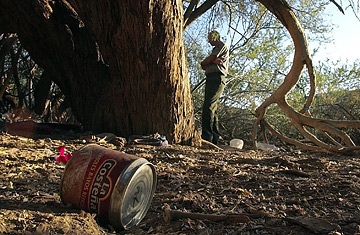
A park officer at Organ Pipe Cactus National Monument in southern Arizona stands among discarded water bottles, canned food and clothing at the base of an ironwood tree.
Cabeza Prieta is just one part of the 2,000-mile-long border that conservationists are increasingly worried about. While politicians of all stripes focus on the human side of the noisy immigration debate, there is a rising concern over what illegal immigration and the U.S. response to it may do to the area's fragile ecosystems. The $7.6 billion federal Secure Border Initiative passed last year calls for the construction of 370 miles of pedestrian fence along the border by 2008 — 129 miles in Arizona, 153 in Texas, 76 in California and 12 in New Mexico. Pedestrian fences have so far proved useful in inhibiting human traffic, but conservationists and others worry they limit access to the habitat for endangered species such as jaguars and the antelope-like Sonoran Desert pronghorn.
Aerial views taken of Cabeza Prieta in 1998 show an almost pristine wilderness, according to the refuge's land manager, Roger DiRosa. But ever since the late 1990s, when U.S. Border Patrol officials embarked on several aggressive, successful clampdowns near El Paso, Texas, and San Diego, California, much of the illegal human traffic has shifted to the wilderness areas around New Mexico and Arizona.
Like his fellow Arizona border land managers, DiRosa said he is practicing "triage — trying to figure out what to sacrifice to save the whole." Of the 1,200 miles of illegal roads and footpaths, some 450 miles are entrenched, the denuded desert pounded out to "moon dust." Some tracks are 100 yards wide and, even if abandoned, will take several generations to return to wilderness. When it rains, they turn into vast dry creek beds, distorting the rainfall patterns. Beyond the roads are staging areas so polluted with human waste and garbage that DiRosa must bring in commercial cleanup crews rather than rely on volunteers. One recent study estimated that each person crossing the desert leaves about eight pounds of garbage in his or her wake. Last year, the Border Patrol apprehended half a million illegal immigrants in Arizona; that means that, even if you only count the illegals who were apprehended and use a conservative estimate of five pounds of garbage for each, 2.5 million pounds of trash were left behind.
DiRosa says "50 to 60% of my budget" is focused on border issues, not wilderness protection. He jokes that he has love-hate relationship with the Border Patrol — where illegals go, the Border Patrol follows, further impacting the wilderness. "It's a Catch-22 — we are joined at the hip," he said. "But if the Border Patrol was not out there it would be a war zone."
In 2002, a park ranger at neighboring Organ Pipe Cactus National Monument was killed by drug smugglers. Vehicle barriers, which allow animals to pass back and forth, are now in place along parts of the Arizona border. More are planned and will soon be protecting Cabeza Prieta. But drug smugglers have adapted and DiRosa said there has been an increase in backpacking gangs. On the Mexican side, conservationists face the same challenges — one large Mexican refuge has several clandestine airstrips operated by the cartels, which operate with impunity.
Still DiRosa insists, "You can't put a bar on this border. Anything you put is nothing more than a lock that has to be watched. We need detection technology, patrols." Retaining open borders for wildlife may mean using several approaches, including vehicle and pedestrian barriers in some areas, technology, drones, radar and more human patrols in others, he said.
